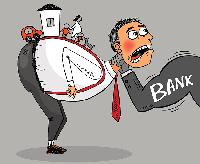
Soaring NPAs (Non-Performing Assets) shows the misery of the country’s banking system in recent years. Most explanations for this rising NPAs points at stalled projects, wilful defaulters, declining profit etc. as the reasons. But a more correct and a general reason is that NPA is a residue of the performance of the economy. To understand the NPA scenario correctly we should understand the pro-cyclical nature of bank lending.
Banks generally gives high volume of loans when the economy is in good shape or during boom. When there is boom, assets and income of borrowers will be high. Value of property etc. being at peak level enables investors/business people to borrow heavily citing their wealth and prospects. Banks give loans depending upon the value of the mortgaged assets.
Later, when recession comes after the boom, (for every boom there will be a recession) the value of mortgaged assets falls. The income, profit and thus the repayment capacity of borrowers come down resulting in non-payment or NPAs. The large volume of loans given during boom will not come back smoothly during recession.
Many times, the RBI caution banks to show restraint during the time of boom. But not much impact as most banks will be in a chase to expand business during good time. When recession hits, they go for cover and many banks will be compelled to take difficult decisions and even loss.
All we can observe here is that banks suffer from economic cycles (boom and recession). Wilful default, other types of default etc. just reflect the economic conditions like recession. We hence describe that banks are ‘procyclical’ or they suffer from ‘porcyclicality’.
In recent years, regulators like BIS (Bank for International Settlement) have invented many measures to overcome this procyclical troubles. Under Basel III norms, banks have to set apart a part of their capital to meet the cyclical difficulties or bad time and it is known as counter cyclical capital buffer. This capital buffer is the money that can be used to meet the NPA situation during bad times like recession. As per the Basel III norms banks have to keep a counter cyclical capital buffer of around 2.5% (capital kept as a percentage of their assets/loans given).
*********









